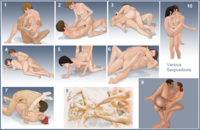
Photo from wikipedia
I read with great interest the review article recently published by McMonnies [1] regarding eye rubbing-related intra-ocular pressure (IOP) elevation in the development and progression of keratoconus (KC). Although we… Click to show full abstract
I read with great interest the review article recently published by McMonnies [1] regarding eye rubbing-related intra-ocular pressure (IOP) elevation in the development and progression of keratoconus (KC). Although we congratulate the author for highlighting the importance of eye rubbing and KC pathogenesis, some important points that support the primary role of IOP elevation in the context of eye rubbing still need to be considered. First, the relationship between KC and the onset and progression of primary open angle glaucoma (POAG) cannot be observed in a clinical setting [2]. If elevated IOP during rubbing is so relevant in terms of corneal bulging, rubbing would also be expected to damage the optic nerve and retinal fiber layer. In addition, in very asymmetric cases, an eye with severe KC would present an increased cup-to-disc ratio compared to mild or form frustre contralateral eye. Again, this finding has not been observed [3]. The concept of corneal bulging/distention due to IOP forces needs to be investigated. The concept invokes the notion of an increase in surface area occurs via a stretching process [4]. However, this idea is not exactly an accurate description of the morphology of the keratoconic cornea. A true bulge would necessarily dictate an increase in surface area of the cornea, such as in keratoglobus in which the surface expands [5]. In contrast, surface area tends to be conserved to the same degree as in corneas with KC, promoting an isometric type of distortion or warping in the majority of cases. Hence, the flattening seen in the periphery of keratoconic corneas (increased prolateness) corresponds to a coupling effect that compensates for the increase in curvature in the cone region [6]. What happens to a young patient’s cornea when he is subject to constantly elevated IOP? It has been reported that cases of childhood glaucoma corneas have flatter keratometry, greater diameter, and relatively thicker corneas than normal corneas [7,8]. Only a statistically significant increase in posterior corneal elevation in eyes with childhood glaucoma, both unoperated and operated, was found, although no significant difference in anterior corneal elevation and pachymetry was observed [9]. Finally, I agree with the author that eye rubbing is the most important risk factor for KC development and progression (perhaps sine qua non) and causes substantial transient IOP elevation. However, the lack of relationship between KC, POAG, and childhood glaucoma in addition to the morphology of corneal deformation questions the importance of IOP elevation in KC pathogenesis. Funding
Journal Title: Expert Review of Ophthalmology
Year Published: 2023
Link to full text (if available)
Share on Social Media: Sign Up to like & get
recommendations!